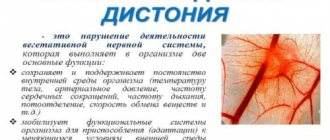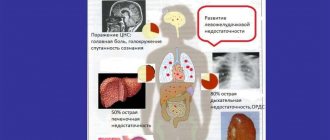What is vegetative-vascular dystonia
Vegetative-vascular dystonia is a complex disease that involves a disruption of the human autonomic nervous system.
In modern medical practice, this pathology is called otherwise - somatoform autonomic dysfunction of the nervous system.
Often, the diagnosis of VSD hides more serious pathologies and diseases. As a rule, the disease is the tip of the iceberg and occurs against the background of dysfunction of the somatic and nervous system.
It is provoked by a number of mental disorders. During pregnancy, it often occurs due to hormonal changes.
It occurs in almost every 3 pregnant women. Often, expectant mothers are not aware of the presence of such a pathology before pregnancy.
After conception, symptoms become more pronounced, and the disease is easier to diagnose.
Concept, types, clinical manifestations of vegetative-vascular dystonia
Clinical symptoms of VSD
Vegetovascular dystonia is a pathological condition caused by disruption of the autonomic nervous system. The patient has a divergence of functions between the sympathetic and parasympathetic departments. Autonomic structures are responsible for the functioning of all body systems, therefore, when they are dysfunctional, various types of VSD can appear. Autonomic dystonia is classified according to the predominance of a specific clinical syndrome.
Types of VSD
| Variety | Symptoms |
| Cardiac | Pain in the heart, changes in heart rhythm, anxiety, high blood pressure. Pain in the heart does not go away when taking nitroglycerin. |
| Hypotonic | Decreased blood pressure during stress or at rest, fainting, weakness, increased fatigue. |
| Hypertensive | Arterial hypertension during stressful situations, physical activity or at rest. |
| Visceral | Abdominal pain, inconsistent stool (diarrhea gives way to constipation and vice versa). |
| Tachycardial | Heart rate reaches 140-160 beats per minute, hypertension, pulsation in the temples, redness of the face. |
| Asthenic | Chronic fatigue syndrome, hyperthermia up to 37.5, hand tremor (shaking). |
| Respiratory | Difficulty breathing, tightness in the chest, yawning, lump in the throat, dry cough, shallow breathing. |
| Mixed | Includes several types. |
VSD syndromes:
- Cardiovascular (differences in blood pressure (high, low), changes in heart rhythm, vascular reactions, pain or discomfort in the heart area).
- Hyperventilation (rapid breathing, heaviness in the chest, shortness of breath with excitement, inability to fully inhale, dizziness).
- Irritable bowel syndrome (abdominal pain, stool disturbances, frequent urge to defecate, dyspeptic symptoms (nausea, vomiting), swallowing pathology).
- Sweating disorders (excessive sweating, especially of the palms and feet).
- Cystalgia (pain in the bladder area, urine tests are unchanged, frequent urge to urinate).
- Libido disorders.
- Changes in thermoregulation (deviation of temperature indicators from the norm against the background of good health, chills).
- Psychoneurological manifestations (tearfulness, irritability, disturbance of sleep patterns and quality, dizziness, tinnitus, headaches).
How it manifests itself
It does not have strictly defined symptomatic signs. It can manifest itself in different ways depending on the reason that provoked it.
Most common symptoms:
- feeling of fear for no apparent reason;
- anxiety and restlessness;
- psycho-emotional stress;
- chronic feeling of fatigue;
- redness of the skin of the face and neck;
- feeling of warmth on the skin of the face and neck;
- trembling of the limbs, especially the hands;
- hands and feet are cold to the touch;
- feeling of numbness in various parts of the body;
- excessive sweating.
If vegetative-vascular dystonia has a severe degree of development, then the following symptoms may be added to the above symptoms:
- sudden loss of consciousness;
- feeling dizzy;
- headaches or migraines;
- low hemoglobin concentration in the blood and anemia;
- pain in the heart area;
- swelling.
If during pregnancy a woman discovers one or more symptoms from the list, then this is a serious reason to consult a doctor as soon as possible for advice. After undergoing an additional examination, the specialist will confirm or refute the diagnosis.
Types of VSD and symptoms in pregnant women
The variety of symptoms of vegetative-vascular dystonia during pregnancy is explained by the fact that this is not a specific disease.
In essence, there is a syndrome that includes the pathology of an imbalance of the autonomic nervous system. In the International Classification of Diseases, 10th revision, there is no such diagnosis as VSD.
Scientists have divided VSD into several types according to the types of signs that appear, the organs affected:
- Hypotonic - the patient constantly feels tired and often experiences faintness. A feeling of fatigue occurs with the slightest physical activity. During times of stress, blood pressure decreases.
- Hypertensive – characterized by an increase in blood pressure during stress or physical activity. Accompanied by headaches, tinnitus, nausea.
- The visceral type affects the gastrointestinal tract. With it, pain periodically occurs in the abdominal area, constipation alternates with diarrhea.
- Respiratory option. Problems are concentrated in the respiratory area. It is difficult for the patient to take a deep breath, she regularly begins to choke, her breathing is shallow. Characterized by a feeling of a lump in the throat, suffocation, and tightness in the chest area.
- Mixed, the most common type. Includes characteristics of several different species, appearing simultaneously or alternately.
Certain types of VSD during pregnancy can imitate severe manifestations of toxicosis (preeclampsia, eclampsia). For example, arterial hypertension. Therefore, manifestations of ill health and poor health are a reason to once again consult a doctor. And make sure everything is okay with mom and baby.
After being examined by your doctor, depending on the symptoms identified, you will need to consult with a doctor who specializes in the system affected by the syndrome.
Causes
VSD during pregnancy has the following causes:
- instability of the psycho-emotional sphere;
- lesions and diseases of the central nervous system;
- disruption of the endocrine system and hormonal balance;
- having a lot of excess weight;
- heredity.
Doctors are of the opinion that the causes may be different and even atypical factors. This is due to the fact that dystonia rarely exists as a separate disease. More often this is a side effect of existing pathologies.
The above reasons form a certain risk group. If a woman has one of the variants of deviations, then the risk of developing VSD is quite high.
During pregnancy, one of the most common causes of pathology is changes in hormonal levels.
A woman experiences a sharp decrease in the amount of some biological substances and an increase in others. This can negatively affect the functioning of the peripheral nervous system.
Causes of autonomic disorders
Factors provoking vegetative-vascular dystonia
The main causes of VSD are considered to be various diseases of organs and systems, bad habits, hereditary factors, stressful situations, and psychiatric disorders.
- heredity;
- hormonal changes (puberty in adolescents, pregnancy, menopause);
- endocrinopathies (diseases of the thyroid gland, adrenal glands, gonads, pancreas);
- neurological and psychiatric abnormalities, overwork (stress, neurosis-like conditions, panic attacks, emotional and physical stress);
- pathologies of the spine and brain (osteochondrosis, trauma, tumors, strokes, dyscirculatory encephalopathy);
- chronic pathological conditions;
- infections, poisoning, allergies;
- smoking, sudden cessation of smoking, alcohol;
- change of place of residence;
- type of temperament (melancholic, choleric).
Types and associated symptoms
Doctors distinguish the following types of vegetative-vascular dystonia:
- hypotonic;
- hypertensive;
- mixed.
VSD of the hypertensive type during pregnancy is manifested by severe headaches, which often turn into migraines. The expectant mother may experience panic attacks for no reason, nervousness and excessive anxiety.
This type of dystonia often provokes severe gestosis in the last trimester of the perinatal period.
VSD of the hypotonic type during pregnancy is accompanied by the development of insufficient placental function and the occurrence of anemia against the background of low hemoglobin in the blood.
As a rule, women with this type of pathology are underweight. The child often receives insufficient oxygen and nutrients, which can cause intrauterine growth retardation and hypoxia.
VSD of mixed type during pregnancy has the most severe consequences. The woman becomes very irritable, nervous and emotionally unstable.
Placental circulation is severely affected. In most cases, this type of dystonia is accompanied by pathologies in the child’s development.
Manifestations of VSD during gestation, consequences
For the first time, VSD during pregnancy occurs due to hormonal changes that occur after conception. Hormonal changes are necessary to maintain the vital functions of the fetus, the formation of the placenta, and maintain the normal tone of the uterus.
At the initial stage of gestation, VSD is observed during pregnancy of the hypotonic type. Patients often report low blood pressure, dizziness, darkening of the eyes, headaches, and fainting.
With VSD of the hypotonic type, the pregnant woman complains of dizziness and weakness
If autonomic disorders are already present before conception, the course of the disease may be aggravated. Symptoms of VSD intensify several times. VSD often occurs of a mixed type during pregnancy. Patients complain of chest pain that is not relieved by nitroglycerin. Women report interruptions in heart function, palpitations, nausea, and vomiting. Symptoms of VSD in most patients are aggravated by toxicosis in the early and late stages of gestation.
Mental disorders and pregnancy
VSD can be complicated by neuroses and panic attacks. These conditions have a negative impact on the course of pregnancy, increasing the likelihood of early miscarriages, as well as premature birth. Women develop anxiety about their unborn baby. Stressful situations only worsen the condition of patients. There is a constant threat of miscarriage throughout pregnancy. In such women, the tone of the uterus is constantly increased, which provokes a lack of oxygen in the fetus.
Panic attacks worsen before childbirth, as well as during the labor period. Such women are often very afraid of giving birth; they have a strong fear of pain. Fear weakens the intensity of labor, which threatens the development of fetal hypoxia.
A panic attack in a pregnant woman is stressful for the fetus
Impact of VSD on the fetus and the course of pregnancy
VSD can provoke various complications of the course. According to the literature, the first trimester of pregnancy proceeds well.
The most serious complication in patients with VSD is gestosis. It manifests itself in the second and third trimester of gestation.
Preeclampsia in pregnant women is manifested by increased blood pressure, impaired renal function, fluid retention in the body, the presence of protein in urine analysis, and poses a danger to the unborn child. Gestosis can provoke fetoplacental insufficiency, premature placental abruption, as well as developmental delay or intrauterine death of the fetus. In most patients, gestosis is difficult to correct with medications. Due to the severity of the condition of the pregnant woman and the fetus, delivery in women with VSD and gestosis is carried out in the early gestational stages (32-33 weeks). During this period, the mortality rate of children after birth increases, severe developmental delay is observed, and eye pathologies in newborns (retinopathy) are also common.
Planning pregnancy with VSD
When planning a pregnancy, a woman needs to see a doctor to clarify the diagnosis, as well as prescribe treatment for autonomic disorders. VSD can provoke amenorrhea in women, menstrual irregularities, and lack of ovulation. Correctly selected treatment will help facilitate and speed up the process of conception.
At the stage of planning a child, it is necessary to closely engage in the treatment and prevention of VSD
VSD is not a contraindication to conceiving a child.
If a woman has mental disorders (panic attacks, neuroses) before pregnancy, she needs to consult a psychologist or psychotherapist. Trainings, conversations, and taking medications will help reduce the severity of clinical manifestations.
How does VSD occur at different stages of pregnancy?
In the first 12 weeks of the perinatal period, women experience an exacerbation of the symptomatic manifestations of VSD.
This is due to the fact that during this period the body is just beginning to adapt to hormonal changes and its new status. Against this background, panic attacks, anxiety, and feelings of guarding worsen. The woman becomes very emotional and irritable.
In the second trimester, symptoms become less pronounced because... During this period, the body has already adapted, and excess load from the growing fetus has not yet appeared. Therefore, many pregnant women at 13-28 weeks notice improvements in their condition.
Starting from the 30th week of pregnancy, negative manifestations again make themselves felt in full force. Many expectant mothers are faced with the phenomenon of late toxicosis or gestosis. This condition is quite dangerous not only for the woman, but also for the child.
As a rule, in such cases, the pregnant woman is hospitalized and left under the supervision of doctors.
Regardless of the duration of pregnancy, vegetative-vascular dystonia requires regular medical supervision.
Treatment of VSD during pregnancy
Various therapeutic approaches may be used. Currently, VSD and pregnancy almost always accompany each other, but this does not mean that there is no need to pay attention to the syndrome. A woman must describe in detail to her doctor all the symptoms she is experiencing so that he can select a treatment regimen. There are options in both traditional and alternative therapies.
Medicines
First of all, it is important to understand that any drug that a woman takes will enter the fetus’s body through the placenta and cause harm to it. It is strictly forbidden to take any medications without the knowledge of a doctor. As a rule, traditional medications for the treatment of vascular dystonia (antidepressants, tranquilizers and antipsychotics) will have to be abandoned, especially in the first trimester. They can be prescribed only in exceptional cases in case of very severe VSD, after carrying out all the necessary tests and determining an accurate diagnosis.
To alleviate the condition, a woman may be prescribed herbal medications during pregnancy:
- Persen;
- Novopassit;
- motherwort;
- tablets to normalize vascular pressure;
- potassium and calcium preparations;
- multivitamin complexes (it is very important to ensure that the body receives the required amount of B vitamins);
- medications for gestosis when it occurs.
As prescribed by a doctor, mild tranquilizers, antidepressants, and psychotropic drugs may be recommended:
- Diazepam;
- Carbamazepine;
- Pyrininol;
- Mezapam;
- Sonapax.
Folk remedies
There are several effective recipes:
- Mix the herbs of Rhodiola rosea, Leuzea, and mistletoe in equal proportions. Pour 15 g of the collection into 250 ml of boiling water. Cook for a quarter of an hour in a steam bath. Drink the decoction before bed.
- Take a tablespoon of dandelion, chicory and cornflower, pour half a liter of boiling water. Insist all night. Drink 100 ml half an hour before meals.
- Add 3 tbsp to 100 ml of fresh carrot juice. l. red wine, 15-20 g honey. Consume this mixture throughout the day.
The effect of the disease on the fetus
Against the background of VSD in the mother, the developing child may experience the following complications and pathologies:
- intrauterine anemia;
- iron deficiency syndrome;
- oxygen starvation and hypoxia;
- insufficient supply of nutrients;
- intrauterine growth retardation;
- intrauterine ischemic stroke;
- insufficient weight gain;
- low activity of the immune system;
- impaired mental function;
- autism or mental retardation after birth.
Quite often, women do not treat dystonia with due responsibility. However, the child who develops in the womb perceives the disease as a very serious pathology. It has an extremely negative impact on his health and development.
VSD and pregnancy: how to carry and give birth to a healthy child?
First of all, a pregnant woman suffering from vegetative-vascular dystonia must strictly follow the advice of the doctor supervising her. If necessary, take prescribed medications, and under no circumstances self-medicate. If any deviations occur or your condition worsens, immediately inform the doctor; he must be aware of the slightest changes in your health condition in order to react correctly and, most importantly, in a timely manner and take measures to stabilize it. This way, you can safely carry your baby, protect him from negative influences and give birth to a full-fledged and healthy baby.
VSD during pregnancy symptoms
How can vegetative-vascular dystonia manifest in a pregnant woman, and what changes in her condition should she pay attention to? The following symptoms should not be ignored:
- Constant fatigue.
- Meteor dependence.
- Unreasonable increase in heart rate.
- Bloating, constipation and other problems in the gastrointestinal tract.
- Frequent dizziness and headache.
- Insomnia, restless sleep.
- Unreasonable attacks of anxiety and fear, irritability.
- Dilated pupils.
- Numbness and tingling of the body.
There may be other signs of existing pathology in the vegetative-vascular system, depending on the type of disease and the physiological characteristics of the pregnant woman. Thus, patients with a thin build most often experience low blood pressure, suffer from anemia, and may be prone to frequent fainting. Women who are overweight, on the contrary, are prone to increased blood pressure, excessive sweating and swelling. The most dangerous and unpredictable for a pregnant woman is mixed type dystonia. In this case, special attention and monitoring of blood pressure levels are required, and its constant regulation within normal limits.
It is quite possible for a pregnant woman to carry and give birth to a full-fledged child if VSD is present. This diagnosis is not a contraindication to conception and childbirth. It’s just that in such cases, expectant mothers should take special care of their health and constantly monitor their condition, both physical and emotional. While pregnant, women are subject to frequent mood swings, mental excitability and other stressful conditions.
All these conditions have an extremely negative impact on the development of the fetus, and are especially dangerous if a pregnant woman is diagnosed with VSD. Therefore, the expectant mother should take care that her baby feels comfortable and calm. After all, his health directly depends on the health of the woman who carries this small and still defenseless tiny creature under her heart. Take care of yourself, control your emotional and general state, do not give in to panic and the desire to cry for no reason, because, first of all, your baby will suffer from this. Follow strictly all the advice and recommendations of your doctor, and you will have a healthy and strong baby.
Vegetovascular dystonia does not develop with the onset of pregnancy.
Its long-standing form is activated against the background of hormonal changes. Along with unpleasant symptoms for the whole body, everything during pregnancy brings additional worries to the expectant mother and adversely affects the health of the baby.
A diagnosis of VSD of any type is not a disease; it is not an indication for termination of pregnancy. The doctor will correct the situation by establishing a daily routine or prescribing medications.
Diagnosis and treatment
Diagnosis of this disease includes:
- consultation with a neurologist;
- psychiatrist consultation;
- examinations by specialists to eliminate the root cause.
Treatment of VSD during pregnancy is prescribed only by a doctor after the woman has undergone a comprehensive examination and the cause of the pathology has been established.
At the first stages, therapy will be aimed at normalizing the woman’s psycho-emotional state without the use of medications. It includes:
- reducing the number of psychological stimuli;
- reduction of physical activity;
- adherence to daily routine;
- normalization of the period of sleep and wakefulness;
- walks in the open air;
- proper nutrition and drinking regime.
Following these recommendations helps put dystonia into remission.
If an exacerbation of VSD occurs during pregnancy, acceptable drug treatment is selected. It involves taking special sedatives and antidepressants.
If dystonia develops against the background of high blood pressure, additional medications are prescribed to normalize it.
Causes and diagnosis
Vegetative-vascular dystonia occurs mainly due to a combination of factors layered on top of each other, such as:
- Physical and mental overload;
- Stressful situations;
- Sudden climate change;
- Moving;
- Neuroses;
- Hormone surges that occur during pregnancy and puberty;
- Malfunctions of the thyroid gland and adrenal glands;
- Pathologies of internal organs that are chronic in nature such as inflammation of the liver and pancreas;
- Head injuries;
- Manifestation of allergies;
- Genetic predisposition.
People who are often exposed to these factors are at risk.
Only a doctor can make a diagnosis of VSD after diagnosis, questioning and examination of the patient. Among the instrumental examination methods the following can be distinguished:
- Ultrasound;
- Tests (blood, urine, feces);
- ECG;
- CT, MRI.
Complications
Vegetative-vascular dystonia provokes pregnancy complications. The most common are:
- pathologies of blood supply in the body of a woman and child;
- disruption of the kidneys and excretory system of a woman;
- premature aging of the placenta;
- detachment of membranes;
- retinal detachment in a woman;
- miscarriage;
- premature birth;
- stopping the development of pregnancy;
- toxicosis and gestosis;
- excess body weight gain;
- thyroid dysfunction.
Is it possible to get pregnant with VSD? This question worries every woman who has faced this diagnosis. Dystonia is not a contraindication to pregnancy. Therefore, you should not refuse this wonderful event. However, such a pregnancy should be under constant medical supervision.
Prevention of VSD and is it possible to get pregnant?
When preventing vegetative-vascular dystonia during pregnancy, lifestyle before conception and her health play an important role. Before the intended conception, it is recommended to undergo a complete examination of the body, to cure chronic and inflammatory processes. Get tested for sexually transmitted infections. A serious approach to your health is already half the success; a woman will be able to carry a baby and give birth correctly.
In addition, it is worth reconsidering your lifestyle during VSD during pregnancy:
- it is necessary to lead an active lifestyle, refuse sedentary work;
- exercise;
- eat rationally and drink more water;
- eliminate bad habits from your life (alcohol, smoking);
- eat more fruits, vitamins and vegetables, reduce consumption of spicy and fatty foods;
- try to reduce the amount of stress;
- sleep should be at least eight hours (daytime sleep is recommended);
Remember! Following these simple rules can completely eliminate the occurrence of VSD during pregnancy or reduce the number of symptoms. Thanks to which pregnancy will become a joyful period, and the baby will be healthy
Course of therapy
In case of VSD, the attending physician should answer what to do, because many medications are contraindicated. Experts usually recommend monitoring blood pressure, heart rate and temperature. In general, the course of therapy consists of the following groups of drugs:
- Vitamin complexes;
- Medicines to improve blood flow such as nicotinic acid;
- Preparations with a calming effect based on herbs. In more severe cases, after consultation with a doctor, tranquilizers, antidepressants and psychotropic medications are used.
During treatment, special attention is paid to relieving symptoms, but it is prohibited to use tablets on your own. In addition to drug therapy, other methods can be used:
- Swimming in the pool;
- Massotherapy;
- Acupuncture;
- Physiotherapeutic procedures.
During pregnancy, treatment with traditional recipes is quite acceptable. For example, you can use an infusion of chicory, dandelion and violet. All components need to be poured 1 tbsp. l. into a thermos and pour boiling water over it. A decoction of angelica, rhodiola, mistletoe and leuzea is prepared in the same way. You need to take 1/3 cup before meals.
Treatment of VSD in pregnant women should begin with lifestyle changes. To do this you will have to follow these rules:
- Make a daily schedule and strictly follow it;
- Engage in physical therapy;
- Walk before bed and after eating;
- Eat properly;
- Eliminate bad habits;
- Sleep at least 8 hours a day;
- Use relaxation techniques such as color therapy, sound therapy and aromatherapy.
Basic recommendations
Physical education will be an effective treatment and prevention of this condition. It is very important to do morning exercises every day. Water procedures are also useful, so take a shower, shower yourself and do contrasting foot baths. Overwork is unacceptable for an expectant mother; you definitely need to sleep at least 10-12 hours a day. The condition is worsened by taking hot baths and standing for long periods of time, as well as staying in a stuffy room.
Before starting therapy, be sure to consult with your doctor about how to treat VSD. Pregnancies are very different from each other, so it is not a fact that the prescription made to a friend will be optimal for you. With VSD of the hypotonic type, you need to adhere to a reasonable diet. Nutrition should be complete, but not very plentiful. In the morning you can drink strong tea; B vitamins and natural stimulants are prescribed throughout the day. These are herbal remedies that have a tonic effect, that is, lemongrass and ginseng.
Diagnosis of pathology
The diagnosis for expectant mothers can be made after a comprehensive examination. Suspicion of vegetative-vascular dystonia is confirmed (refuted) based on:
- measuring blood pressure and heart rate;
- examination of the patient and analysis of her complaints about her health;
- studying the results of the electrocardiogram.
In rare cases, the doctor prescribes additional diagnostic tests - ultrasound, MRI or CT scan of the brain. The diagnosis is confirmed if vegetative symptoms are not accompanied by organic pathologies.











